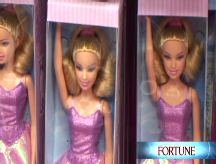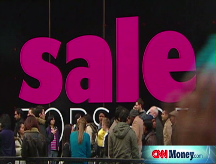One in 3 toys is toxic, group says
Environmental group says many items for sale have high levels of lead, arsenic and other chemicals.
NEW YORK (CNNMoney.com) -- One in three toys tested was found to contain toxic chemicals such as lead, flame retardants and arsenic, according to a report issued Wednesday by an environmental group.
Researchers for the Michigan-based Ecology Center tested more than 1,500 popular toys for lead, cadmium, arsenic, PVC and other harmful chemicals. They said they found that one-third of the toys contain "medium" or "high" levels of chemicals of concern.
"Our hope is that by empowering consumers with this information, manufacturers and lawmakers will feel the pressure to start phasing out the most harmful substances immediately, and to change the nation's laws to protect children from highly toxic chemicals," said Ecology Center's Jeff Gearhart, who led the research, in a written release.
The group said it selected toys and children's products that attempted to represent a cross section of the most popular items used by U.S. children.
Researchers bought the toys at chain stores including Target, Kmart, Toys R Us, Babies R Us, TJ Maxx, and Wal-Mart, as well as drug stores, dollar stores, on-line retailers and independent toy stores, according to the HealthyToys.org Web site, where the report was posted.
The toys were purchased at stores in Ann Arbor and Ypsilanti, Mich.; Oakland, Calif.; and Albany, N.Y.
The group's Web site said that the sampling was not random or intended to be representative of all toys on the market. The toys were tested using a handheld X-ray fluorescence (XRF) device that uses x-ray fluorescence spectrometry to detect chemicals like lead, cadmium, chlorine, arsenic, mercury, tin, and antimony.
A group representing the toy industry was critical of the report.
"The Toy Industry Association finds the report from Healthytoys.org is misleading to consumers, at best," according to a statement on the company's Web site.
"The truth is toys are a highly regulated industry that has been subject to even more intense scrutiny - from industry, retailers, government and consumer organizations - in the past 18 months," the association said in its statement. "TIA members are always working hard to ensure that toys sold in the U.S. meet or exceed all safety standards - so consumers can be confident in the safety of toys."
Gearhart said HealthyToys.org, which he says is a project of the Ecology Center, encourages retailers to be responsible in what kinds of products they sell. But he said manufacturers are ultimately responsible for maintaining the safety standards of the toys they make.
He said manufacturers should be more aggressive that minimal requirement in testing toy safety.
"The manufacturer will test to meet regulatory standards," said Gearhart. "Complying with regulatory standards should be the baseline."
In February, new regulations from the Consumer Product Safety Commission will make some of the toys now available for purchase illegal to sell, according to a press release from the group.
"Many of the products that are on our high concern list are ones that will have difficulty complying with the new standards that come into play in February - but not all of them, because we are looking at more restrictive screening that what the toy industry does," said Gearhart.
The study found lead in 20% of the toys tested. In 3.5% of the toys, or 54 items, levels of lead exceeded the federal recall level for paint, 600 parts-per-million.
The number of toys that showed more than 600 ppm of lead decreased by half from 2007, when 7% of the toys tested were found to have more than 600 ppm of lead, according to Gearhart.
Also according to the study, children's jewelry is 5 times more likely to contain lead above the toxic 600 ppm-level than other toys. In particular, the report mentioned that several Hannah Montana brand jewelry items tested high for lead.
The American Academy of Pediatrics recommends that children's toys have less than 40 parts-per-million of lead. The levels of lead detected in "many" of the toys was "significantly" above those guidelines, according to the release.
The study does not associate country of origin with the presence of toxic chemicals. According to the release, 21% of toys from China and 16% of toys from all other countries had detectable levels of lead.
Of the 17 toys made in the United States that were tested, 35% had detectable levels of lead. A U.S.-made Halloween pumpkin pin had 190,943 ppm of lead.
The report found that 62% of the tested products - or 954 items - contain low levels of chemical concern. And 21% of the products tested - or 324 items - contained no toxic chemicals to be worried about.
Ecology Center, a nonprofit group, said the study was conducted with several partners. The results were posted at HealthyToys.org. ![]()



